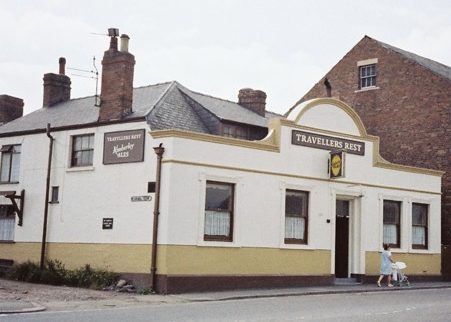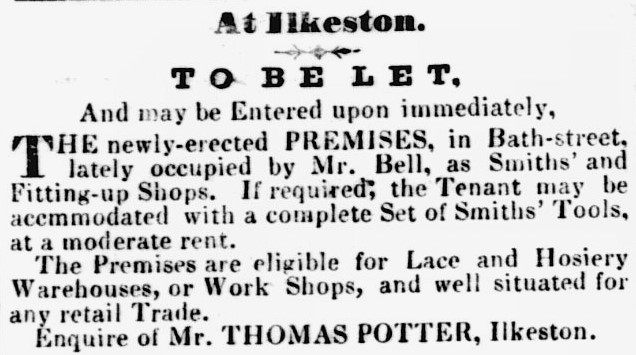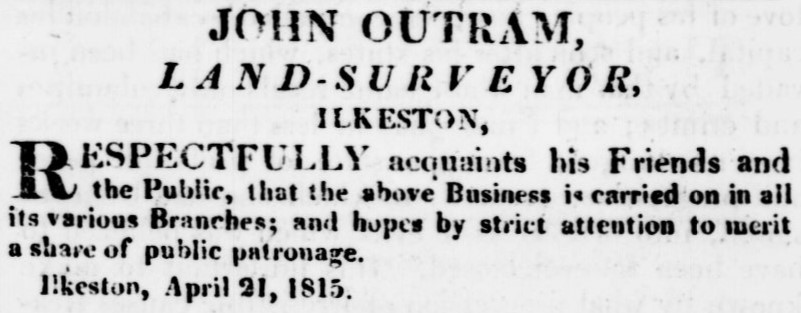What inn is this
Where for the night
Peculiar traveller comes?
Who is the landlord? …………………………… Emily Dickinson 115
—————————————————————————————————————————————————–
Leaving behind James Gallimore we arrive at yet another beerhouse.
a twentieth century view of the Travellers’ Rest before it was demolished, in the winter of 1991/2
The Bell family at the Travellers’ Rest
Adeline states that “in White Lion Square was the Travellers’ Rest, landlady Mrs. (Phoebe) Bell. Her son William Bell junior was landlord after his mother’s death.”
Phoebe Riley was the daughter of Brinsley shoemaker John and Mira (nee Moss) and from April 1825 the wife of William Bell senior, blacksmith, framesmith and victualler, living near the confluence of Nottingham Road and Stanton Road — formerly Boot Lane — in an area previously known as Outram’s Buildings. Before moving to this beerhouse William was trading in Bath Street but then sold up and moved out.
Nottingham Review (April 17th, 1835)
Both originally from Nottinghamshire, Phoebe and William came to Ilkeston after their marriage and raised a family of many daughters and two surviving sons, the elder of whom, William junior, took over the control of the Inn when Phoebe died in December 1879, aged 71. Her husband had died in August 1854.
The children of William and Phoebe Bell ….
Henry died in September 1830, aged 3.
Eliza married needlemaker Amos Tatham on May 24th,1847.
Sarah Ann married miner George Wright on October 14th, 1850 and died on November 30th, 1871, aged 40, at the Spring Cottage Inn in Spring Lane, where her husband was the landlord.
George subsequently lived with his only legitimate daughter Selina and her husband – since February 1872 – Jonathan Slack Pursglove, cabinet maker, upholsterer and paperhanger of Market Street. He died in that street on March 22nd, 1895, aged 74.
Before his marriage George had fathered two illegitimate daughters with Mary Morley, daughter of Cotmanhay schoolmaster John and Mary (nee Henshaw).
One daughter, Elizabeth Morley, married miner Moses Bullivant Henshaw in February 1865, and died at 306 East Main Street, Amsterdam, New York State, in February 1917, aged 72.
The other daughter, Marina, died in infancy.
Selina married warper Hillary Spencer on March 3rd 1851.
Hillary committed suicide, dying at their Regent Street home on May 4th, 1887 after drinking three pennyworth of laudanum earlier purchased from the chemist shop of Charles Potts. He was drunk at the time and had been drinking heavily several days prior to his death.
Ten years later, on August 24th 1897, living with her son George at 13 Stanton Road, Selina suffered a severe accident. On that late summer evening she was taking in her washing line when she caught her knee on a chair, the blow causing a large ulcer to open and bleed profusely. According to her son she had complained about some sort of knee swelling for about two years and when he was called from his work on that evening he found his mother, sitting in the back yard, being attended by her neighbour. That neighbour was Martha Wilkinson (nee Goddard and wife of Robert) who had been alerted to Selina’s accident by Selina’s grand-daughter, nine-year-old Amelia Roberts. She sent the child to fetch the doctor while she tried to stem the bleeding from Selina’s wound … attempts which lasted, fruitlessly, for almost an hour, and by which time Selina had lapsed into unconsciousness. By the time that Dr. William Rankin Patin arrived the patient was still alive but still bleeding profusely, and before he could effectively treat her, Selina died.
Harriett died, aged 7 weeks, in September 1835.
Priscilla married Codnor-born blacksmith Isaac Parkin on April 12th, 1852.
On the 1861 census the Parkin couple can be found at “West’s Yard off Market Street” with their four children. This was not the ‘Market Street’ of today but that side of the upper Market Place from the King’s Head and down to the Harrow Inn. The Yard was named after the West family of drapers who lived there and was approached via an alley at the side of the Market Inn. Issac was then trading as a blacksmith.
At least from 1869 and for many years thereafter the Parkins were publicans at the Erewash Hotel beerhouse in New Street — later Station Road….. though its name does appear as the Railway Hotel in the Derby Mercury of January 1873.
From that time (and like many beerhouse keepers in Ilkeston) Isaac applied for a full licence to allow him to sell spirits, but he was consistently refused.
He tried again in 1882 .. with the same result … despite his argument that the dwellings and population in the area had grown sufficiently to warrant a broader choice of beverages to be offered.
Eventually, in June 1894 Isaac transferred the licence to his son William and then left Ilkeston, with Priscilla, to farm at Fox Holes farm in West Hallam. Almost immediately William applied for a dancing licence but when the Borough Surveyor Henry Kilford inspected the Hotel, he found it in an unsanitary condition. The would-be dancing room was only 12 feet square, big enough for singing but certainly not for dancing !! Application refused !!
Phoebe junior married Cotmanhay lacemaker, later contractor, later publican, Henry Knighton on April 22nd, 1856.
Aged 37, she died – from cirrhosis of the liver!! — in July 1875 when her husband was then landlord of the Granby Arms on Cotmanhay Road.
Harriett the Second married Common coalminer James Beardsley on March 25th, 1861 and for much of the rest of her life lived in Lower Granby Street where she died — at number 42 — in September 1910, aged 70.
After her death her illegitimate son John Bell alias Beardsley continued to live at the Lower Granby Street home.
Caroline married framework knitter George Eaton on June 22nd, 1862 and then lived in Extension Street.
She died on February 13th, 1876, aged 34, suffering from chronic bronchitis and asthma.
William junior married Dale Abbey-born Elizabeth Jacques, daughter of labourer Joseph and Mary Ann (nee Smith) on March 5th, 1872.
Both before and after his marriage he kept the Travellers’ Rest beerhouse until he retired into Havelock Street — accompanied by his elder daughter Phoebe (junior junior ?)– and where he died — at number nine — in 1914. The licence for the beerhouse had been transferred from William to Jabez Barber in April 1897. (In June 1899 the licence passed to John Horspool after Jabez left for the Flower Pot Inn in Chapel Street)
William junior’s other surviving daughter, Mary Ann, married on February 21st, 1892 to coalminer George Straw, a son of Norman Straw of Bright Terrace, off Market Street…. a marriage destined to last only a few years, but time enough for three children.
In the later 1890’s Mary Ann began a relationship with coalminer Robert Henshaw. (see The mystery Henshaws of Chapel Street)
It was William’s daughter Phoebe (junior junior?) who, on the night of October 6th 1892, was standing outside the beerhouse, when she heard the sound of breaking glass. Looking towards the old Toll Bar area at the end of South Street, she saw two young lads, Charles Devoto (aged 10) and Francis Sudbury (aged 12), running away from Elizabeth Cooper’s lock-up sweet shop there. When Elizabeth arrived at her shop on the following morning she found a pane of window glass smashed, and a box of cigarettes, a quantity of liquorice sticks, and some Brazil nuts missing. Following this discovery, young Charles Devoto was visited by Sergeant Riley at his home in Wakefield’s Yard and, it seems, he soon ‘cracked’ under questioning, and revealed the names of all his pals who had been involved in the crime — or so he said. Subsequently, at Ilkeston Petty Sessions, the parents of Charles and his mate, Alfred Trueman (aged 13) were bound over in sums of £5 to see that the boys were of good behaviour for the next six months. The other lads were just bystanders, perhaps guilty of receiving a Brazil nut or a liquorice stick, and were let off.
It was also William’s daughter Phoebe (junior junior?) who had four illegitimate children, at regular intervals, in the 1890s — three born at the Travellers’ Rest, and the last one born at 9 Havelock Street, in 1898. Only one child, William Joseph Bell (November 16th 1894) survived into adulthood. Her next (and third) child was daughter Phoebe (born on May 29th, 1896) who died, aged three weeks, on June 20th, at the Travellers’ Rest … the same place that the inquest into her death was held. The baby seemed to be very healthy, well nourished and with no ailments; she slept in the bed with her mother who breast-fed her regularly. As she did on the night of the 19th June. However when she awoke the next day infant Phoebe lay dead at the side of her mother. An examination by the mid-wife Harriet Eaton (nee Cowlishaw) who had attended the mother during her confinement, concluded that the baby had died ‘from convulsions’, a common occurence in her long experience. The doctor was also sent for but declined to attend … as the baby was already dead !!
Myra married Heanor Road coalminer Wheatley Straw on April 4th, 1864 and a few months later went to live in Park Road, in a house rented from James Goddard, builder and joiner of East Street. There their first child, Samuel, was born on August 5th 1865.
The house rent was 2s 4d per week, payable fortnightly. Unfortunately by June 1866 Wheatley had managed to accumulate rent arrears of nearly £2, and his landlord had lost patience. He wanted payment !!
The last straw — no pun intended — was when he had discovered that Wheatley was keeping pigeons in a bedroom. The coalminer and his family were given a fortnight’s notice to leave. However Wheatley left a little sooner than that, taking all his household goods with him, and without paying off the arrears; it was only after being taken to court, being threatened with a fine and possible imprisonment, with hard labour, that Wheatley consented to a ‘payment plan’ to pay off his debt.
The family then moved into Oxford Street before travelling north to Cotmanhay !!
There Myra died, at 3 Richards’ Yard in 1898, aged 51.
There were several ‘Wheatley Straws’ born in Ilkeston and the given name probably dates back through the Straw family line to the marriage of John Straw and Ann Wheatley in April 1734 at St. Mary’s Church.
Emma remained unmarried, living with her parents and then with her sister Harriet. She died in Station Road on October 27th, 1890, aged 41.
Youngest child George trained as a pattern maker and after his second marriage, to Fanny Wilson at Eastwood on August 12th, 1878, he also kept the Anchor Inn beerhouse there.
George’s first wife was Elizabeth Ann Fullwood of Heanor whom he married on May 17th, 1874, and whose father Henry McKeaver Fullwood was the landlord of the Sir Charles Napier Inn in Langley Mill. She died at the Inn on January 12th, 1878, aged 21.
—————————————————————————————————————————————————–
Trouble at t’Rest; landlord William Bell junior (1844-1914)
Initially the Travellers’ Rest was a beerhouse and its name was ‘singularly inappropriate’ in the view of RBH, recalling the area as it was in the mid-1870’s.
Outside the inn every Saturday evening the Irishmen of this area — and there were many!! — would provide “a series of the most bloodthirsty combats it was possible to imagine”, at times necessitating the participation of William Bell junior.
“I well recollect, as a boy of 7 or 8 years, seeing Mr. Bell himself, who possessed a very straight left, knock down half-a-dozen of the drunken Hibernians, one after the other with admirable coolness and scientific precision”.
I have never seen a situation so dismal that a policeman couldn’t make it worse ….. Brendan Behan
It was ‘the law’ — in the form of police constable William Neath — with which William junior came into conflict in September 1874 when he was accused of keeping a disorderly house and allowing too many drunken people in it. Can you believe it??!
The P.C. had been alerted by loud noises coming from the Travellers’ Rest and had gone inside to investigate. There he discovered the source of the racket — several drunken customers. One however was asleep with his head on the table and the P.C. ordered landlady Elizabeth Bell not to serve any more drink to the latter (!!). She refused.
Enter her husband William junior who immediately ordered ‘the law’ off the premises.
“Get out or I will chuck you out” shouted the innkeeper and true to his work he manhandled the P.C. out of the door. This was just as the latter was threatening charges of permitting drunk and disorderly conduct on the premises, of assault, and whatever else he could think of.
At the subsequent Petty Sessions hearing, several witnesses spoke in William’s defence, but as most of them were members of the ‘drunken party’ their testimony was treated as suspect.
William was convicted and fined 10s and costs, though his licence was not endorsed.
Perhaps William had been feeling vexed with the forces of authority when he encountered P.C. Neath. Earlier in the month his application for a wine and spirits licence had been refused by the magistrates at Heanor Brewster Sessions.
However in September 1875 William’s beerhouse licence was renewed — despite the fact that he had been convicted for permitting drunkenness on his premises and for assault – because his licence had not been endorsed. Perhaps the magistrates might not have been so forgiving had they known what was to come in the next month.
In November 1875 Mr. Neath had now left behind the police force — as well as his common sense — when he tried to get a drink at the Travellers’ Rest one afternoon. He was ordered out by William’s wife, Elizabeth.
Enter – once again– husband William who threatened once more to kick him out.
Perhaps the memory of his fine then took a hold of William, causing the landlord to take a hold… of Mr. Neath’s throat. His strangulation of the ex-PC was interrupted by onlookers who had to prise his hands away.
This led to another fine for William. The latter’s counter charge that Mr. Neath was drunk and refused to leave the inn was considered but dismissed in court.
William had to pay for the costs of that case also.
There is no record that William Neath ever entered the Travellers’ Rest again.
In the late 1870’s William junior was engaged in building alterations at the Inn and the Local Board permitted him to bring forward the frontage of the public house — but charged him for it of course! By 1881 William had discovered that he owned the land he had built on and so the Board had no right to charge him. Thus he applied for – and secured — a £4 rebate!
For several years after Mr. Neath had been ejected from the Travellers’ Rest, William Bell managed the Inn impeccably. But in April 1882, he found himself in trouble once more, when he was charged with supplying drink to a couple of labourers who were clearly drunk when they entered his Inn. William tried to talk himself out of a fine at the Petty Sessions, but to no avail … and another black mark next to his name.
For one of the labourers — Irishman Michael Waldron of Trueman’s Court — this was his fifteenth appearance at court, and he was fined accordingly.
As we have seen (above) the licence for the beerhouse had been transferred from William Bell junior to Jabez Barber in April 1897. Then in June 1899 the licence passed to John Horspool after Jabez left for the Flower Pot Inn in Chapel Street. John Horspool was there until October 1899 when Edwin Morris took over. At this time the beerhouse was known as “the War Office” (perhaps a reference to the Second Boer War, which had broken out in that same month?)
‘Outram’s Building’ appears on the 1841 census, sandwiched between Boot Lane (Stanton Road) and Evans Row.
The Outram connection to Ilkeston may come via John Outram, the son of Joseph and Ann (nee Micklethwaite), married in 1776.
Nottingham Gazette (April 21st, 1815)
Joseph was of a distinguished Alfreton family and had been married twice before, having several other children by his second wife, Elizabeth Hodgkinson.
His son John had owned some land on the east side of what is now Lower Stanton Road, which he sold to Matthew Hobson senior in 1817. He also owned four freehold premises at Outram’s Buildings, including a grocer’s shop and bakehouse. On the 1841 census the baker was George Laurin Raynor who occupied it under a lease, commencing from September 9th, 1835. After John died in May 1837 the houses were put up for auction at the Sir John Warren (August 16th, 1838).
—————————————————————————————————————————————————–
Off White Lion Square was Wakefield’s Yard.




